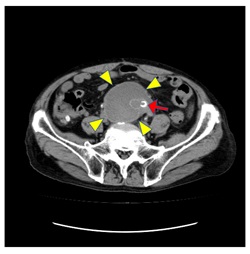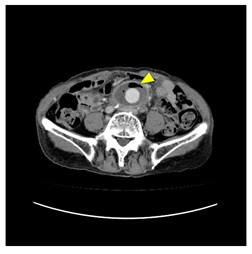
Sigmoid Colon Perforation Associated with Retroperitoneal Fluid Retention After Vascular Surgery
*Corresponding Author(s):
Akira NonogakiDepartment Of Surgery, Gifu Prefectural Tajimi Hospital, Tajimi, Gifu, Japan
Tel:+81 572225311,
Email:nonononoaki@gmail.com
Abstract
A patient with retroperitoneal fluid retention after vascular surgery had a fever of unknown cause. Re-examination suggested fluid infection. Surgery was performed, and the patient was diagnosed with colon perforation. If the fluid volume reduces or the fluid comes into contact with the colon, colon perforation should be suspected.
Keywords
Perforation of the diverticulum in the sigmoid colon; Postoperative infection of artificial blood vessels
Key Clinical Message
Infection due to fluid retention should be considered in patients with retroperitoneal fluid retention after vascular surgery. When retained fluids contact the colon, the fluid may reduce in volume and become filled with air.
A 79-year-old man underwent bypass grafting. From that, retroperitoneal fluid retention was observed around the artificial blood vessel (Figure 1). Despite being asymptomatic, the patient had a fever. Imaging examination revealed no clear cause. Computed Tomography (CT) showed the retained retroperitoneal fluid was in contact with the sigmoid colon and had reduced. There was no improvement with antibiotics, the patient was re-examined. CT showed further reduction of the fluid and internal air (Figure 2). The patient was diagnosed with an infection of retained retroperitoneal fluids involving the sigmoid colon, and surgery was performed. Figure 1: CT showed retroperitoneal fluid retention (yellow arrowhead) around the artificial blood vessel (red arrow). CT, computed tomography.
Figure 1: CT showed retroperitoneal fluid retention (yellow arrowhead) around the artificial blood vessel (red arrow). CT, computed tomography. Figure 2: CT showed the air inside the fluid retained in the retroperitoneum (yellow arrowhead). CT, computed tomography.
Figure 2: CT showed the air inside the fluid retained in the retroperitoneum (yellow arrowhead). CT, computed tomography.
The retained fluids were mixed with pus. In addition to drainage and sigmoid colectomy, artificial blood vessel removal and new bypass grafting were performed. Histopathologically, the diagnosis was inflammation associated with the perforation of a diverticulum in the sigmoid colon [1].
Because the diverticulum of the colon perforated to retroperitoneal fluid retention around the artificial blood vessel, the cause of infection was not detected by imaging, which made the diagnosis difficult. In such patients1, if the retained retroperitoneal fluid is in contact with the intestinal tract or if the retained fluids reduced in the case of an unexplained infection, fluid infection due to gastrointestinal perforation should be considered.
Conflicts of Interest
The authors declare that there are no conflicts of interests.
Financial Disclosures
The authors received no financial support for the preparation of this article.
Acknowledgment
No relevant acknowledgments.
Written informed consent was obtained from the patient to publish this report in accordance with the journal's patient consent policy.
Data availability statement: The data that support the findings are available on request from the corresponding author.
Ethical Statement
Institutional review board approval was exempted at our institution for this retrospectively designed report and informed consent was obtained from the patient to publish this report.
Author’s Contribution
AN: wrote the draft of the manuscript and prepared the figures. AN and TI: involved in writing. AN, TI, SI and TA: revised and approved the final manuscript.
Reference
Citation: Nonogaki A, Ihara T, Ishida S, Asada (2022) Sigmoid Colon Perforation Associated with Retroperitoneal Fluid Retention After Vascular Surgery. J Surg Curr Trend Innov 5: 054.
Copyright: © 2022 Akira Nonogaki, et al. This is an open-access article distributed under the terms of the Creative Commons Attribution License, which permits unrestricted use, distribution, and reproduction in any medium, provided the original author and source are credited.

